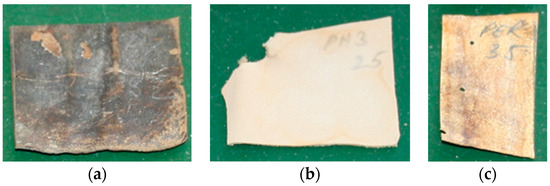Cultural heritage objects suffer from different reasons for degradation, which are often irreversible. They represent the link between the past and the future, and it is our duty to protect them. Among different support materials, leather and paper are the most sensitive materials, due to their organic support, and improper storage conditions can lead to severe damage due to bacterial degradation.
In previous studies, our research group revealed the presence of several species, such as Aspergillus sp. (Aspergillus clavatus and Aspergillus ochraceus), Penicillium sp., Fusarium sp. (Fusarium expansum and Fusarium flavum), Alternaria sp. (Alternaria rudis) and Rhisopus sp. (Rhizopus stolonifera) on selected paper artefacts from the XIXth century [1]. This study demonstrated that even if at visual evaluation, the samples do not appear to be infested, they are damaged at the microscopical level by different bioteriogens. In this context, the necessity of safe treatment methods conducted us to the use of non-invasive treatments, based on nanomaterials, to protect the cultural heritage materials.
For this study, recipes based on synthesized nanostructures were developed in order to be used as pulverizable solutions for obtaining a protective antimicrobial layer. The solutions were tested for efficiency using old natural leather (from historical book covers), new natural leather (lamb, calf, and goat, tanned with vegetable tannins) and old parchment (sheep leather) (Figure 1).

Figure 1.
Aspects of the samples treated with the proposed recipe: Old leather book cover (a); new leather (b); and parchment (c).
The tested nano-recipes showed good antimicrobial properties, accompanied by a slight discoloration of the treated materials, with no deposits of solids visible on the surface of the samples.
Acknowledgments
This work was supported by a grant from the Romanian National Authority for Scientific Research and Innovation, CNCS/CCCDI—UEFISCDI, project number PN-III-P1-1.2-PCCDI-2017-0413, contract 50PCCDI/2018, within PNCDI III and by the Romanian Ministry of Research and Innovation—MCI through the INCDCP ICECHIM Bucharest 2019-2022 Core Program PN. 19.23—Chem-Ergent, Project No.19.23.03.01.
Reference
- Fierascu, I.; Avramescu, S.M.; Fierascu, R.C.; Ortan, A.; Vasilievici, G.; Cimpeanu, C.; Ditu, L.M. Micro-analytical and microbiological investigation of selected book papers from the nineteenth century. J. Therm. Anal. Calorim 2017, 129, 1377–1387. [Google Scholar] [CrossRef]
© 2019 by the authors. Licensee MDPI, Basel, Switzerland. This article is an open access article distributed under the terms and conditions of the Creative Commons Attribution (CC BY) license (https://creativecommons.org/licenses/by/4.0/).